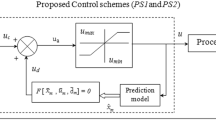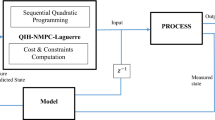Abstract
This work deals with implementation of adaptive nonlinear model-based control (NMBC) scheme on the time varying system. In this approach, only influential model parameter was estimated using well recognized parameter estimation techniques and predicted value of the parameters were used to synthesize the control law. Detailed guidelines on tuning controller parameters were discussed in this paper. In order to demonstrate the practical utility and usefulness of the NMBC control framework, a typical nonlinear industrial process was chosen. The realistic simulations like servo-regulatory compliance, elimination of measurement noise with a state-of-the-art simulator ensures the efficacy of the proposed controller. The performance assessment of the NMBC schemes (computational speed, mean square error (MSE)) were analyzed and compared with the traditional adaptive PI (TA-PI) control strategy. Furthermore, the convergence assessing chart (mean square deviation (MSD)) for different estimators were compared in order to analyze the merits and demerits associated with them. From the extensive simulation studies, robustness features of the aforementioned control schemes have been investigated.





Similar content being viewed by others
REFERENCES
Boyd, S. and Barratt, B.C., Linear Controller Design: Limits of Performance, Englewood Cliffs, N.J.: Prentice Hall, 1991.
Bequette, B.W., Practical approaches to nonlinear control, Nonlinear Model Based Process Control, Berber, R. and Kravaris, C., Eds., NATO ASI Series, vol. 353, Dordrecht: Springer, 1998, pp. 3–32. https://doi.org/10.1007/978-94-011-5094-1_1
Syrmos, V.L., Abdallah, C.T., Dorato, P., and Grigoriadis, K., Static output feedback—A survey, Automatica, 1997, vol. 33, no. 2, pp. 125–137. https://doi.org/10.1016/S0005-1098(96)00141-0
Liu, Y.-J., Li, D.-J., and Tong, S., Adaptive output feedback control for a class of nonlinear systems with full-state constraints, Int. J. Control, 2014, vol. 87, no. 2, pp. 281–290. https://doi.org/10.1080/00207179.2013.828854
Wang, R., Koelewijn, P.J.W., Manchester, I.R., and Tóth, R., Nonlinear parameter-varying state-feedback design for a gyroscope using virtual control contraction metrics, Int. J. Robust Nonlinear Control, 2021, vol. 31, no. 17, pp. 8147–8164. https://doi.org/10.1002/rnc.5559
Findeisen, L., Imsland, F., Allgower, F., and Foss, B.A., State and output feedback nonlinear model predictive control: An overview, Eur. J. Control, 2003, vol. 9, nos. 2–3, pp. 190–206. https://doi.org/10.3166/ejc.9.190-206
Economou, C.G., An operator theory approach to nonlinear controller design, PhD Dissertation, Pasadena, Calif.: California Inst. of Technology, 1985.
Morari, M. and Lee, J.H., Model predictive past, present and future, Comput. Chem. Eng., 1999, nos. 4–5, pp. 667–682. https://doi.org/10.1016/S0098-1354(98)00301-9
Garcia, C., Prett, D., and Morari, M., Model predictive control: theory and practice—A survey, Automatica, 1989, vol. 25, no. 3, pp. 335–348. https://doi.org/10.1016/0005-1098(89)90002-2
Qin, S.J. and Badgwell, T., A survey of industrial model predictive control technology, Control Eng. Pract., 2003, vol. 11, no. 7, pp. 733–764. https://doi.org/10.1016/S0967-0661(02)00186-7
Wang, P., Yang, C., Tian, X., and Huang, D., Adaptive nonlinear model predictive control using an on-line support vector regression updating strategy, Chin. J. Chem. Eng., 2014, vol. 22, no. 7, pp. 774–781. https://doi.org/10.1016/j.cjche.2014.05.004
Han, H.-G., Zhang, L., Hou, Y., and Qiao, J.-F., Nonlinear model predictive control based on a self-organizing recurrent neural network, IEEE Trans. Neural Networks Learn. Syst., 2016, vol. 27, no. 2, pp. 402–415. https://doi.org/10.1109/TNNLS.2015.2465174
Afram, F.J., Janabi-Sharifi, F., Fung, A.S., and Raahemifar, K., Artificial neural network (ANN) based model predictive control (MPC) and optimization of HVAC systems: A state of the art review and case study of a residential HVAC system, Energy Build., 2017, vol. 141, no. 9, pp. 96–113. https://doi.org/10.1016/j.enbuild.2017.02.012
Cheng, L., Liu, W., Hou, Z.-G., Huang, T., Yu, J., and Tan, M., An adaptive Takagi–Sugeno fuzzy model-based predictive controller for piezoelectric actuators, IEEE Trans. Ind. Electron., 2017, vol. 64, no. 4, pp. 3048–3058. https://doi.org/10.1109/TIE.2016.2644603
Kim, T.Y., Kim, B.S., Park, T.C., and Yeo, Y.K., Development of predictive model based control scheme for a molten carbonate fuel cell (MCFC) process, Int. J. Control, Autom. Syst., 2018, vol. 16, pp. 791–803. https://doi.org/10.1007/s12555-016-0234-0
Tan, K.K., Huang, S., and Ferdous, R., Robust self-tuning PID controller for nonlinear systems, IECON’01. 27th Ann. Conf. of the IEEE Industrial Electronics Society, Denver, 2001, IEEE, 2001, vol. 1, pp. 758–763. https://doi.org/10.1109/IECON.2001.976710
Evensen, G., The ensemble Kalman filter: Theoretical formulation and practical implementation, Ocean Dyn., 2003, vol. 53, pp. 343–367. https://doi.org/10.1007/s10236-003-0036-9
Kalman Filtering and Neural Networks, Haykin, S., Ed., New York: John Wiley & Sons, 2001.
Reichle, R.H., Walker, J.P., Koster, R.D., and Houser, P.R., Extended versus ensemble Kalman filtering for land data assimilation, J. Hydrometeorol., 2002, vol. 3, no. 6, pp. 728–740. https://doi.org/10.1175/1525-7541(2002)003<0728:EVEKFF>2.0.CO;2
Julier, S.J. and Uhlmann, J.K., Unscented filtering and nonlinear estimation, Proc. IEEE, 2004, vol. 92, no. 3, pp. 401–422. https://doi.org/10.1109/JPROC.2003.823141
Van der Merwe, R., Wan, E., and Julier, S., Sigma-point Kalman filters for nonlinear estimation and sensor-fusion: Applications to integrated navigation, AIAA Guidance, Navigation, and Control Conf. and Exhibition, Providence, R.I., 2004. https://doi.org/10.2514/6.2004-5120
Refsnes, J.E.G., Nonlinear model-based control of slender body AUVs, PhD Dissertation, Trondheim: Norvegian Univ. of Science and Technology, 2007.
Subbotina, N.N. and Tokmantsev, T.B., Optimal synthesis to inverse problems of dynamics, IFAC Proc. Vol., 2014, vol. 47, no. 3, pp. 5866–5871. https://doi.org/10.3182/20140824-6-ZA-1003.01174
Wakitani, S., Nakanishi, H., Ashida, Y., and Yamamoto T., IFAC-PapersOnLine, 2018, vol. 51, no. 4, pp. 422–425. https://doi.org/10.1016/j.ifacol.2018.06.131
Arasu, S.K., Panda, A., and Prakash, J., Experimental validation of a nonlinear model based control scheme on the variable area tank process, IFAC-PapersOnLine, 2016, vol. 49, no. 1, pp. 30–34. https://doi.org/10.1016/j.ifacol.2016.03.024
Bhadra, S., Panda, A., Bhowmick, P., Goswami, S., and Panda, R.C., Design and application of nonlinear model-based tracking control schemes employing DEKF estimation, Optim. Control Appl. Methods, 2019, vol. 40, no. 5, pp. 938–960. https://doi.org/10.1002/oca.2526
ACKNOWLEDGMENTS
The authors would like to thank to the editor and reviewers for suggesting important corrections and modifications that have enriched the quality and contribution of this paper.
Funding
The authors do not have any financial support from any end.
Author information
Authors and Affiliations
Corresponding author
Ethics declarations
The authors declare that they have no conflicts of interest.
APPENDIX
APPENDIX
1.1 APPENDIX A. CONTINUOUS-TIME PARAMETER FILTER USING EKF ESTIMATION SCHEME
Initialization of the filter [18, 19]:
Time update equations:
Computation of Kalman gain:
\({{{\mathbf{J}}}_{\Theta }}\) is the Jacobian of the observation matrix and can be expressed as
Hence, the measurement update equations are as follows:
1.2 APPENDIX B. CONTINUOUS-TIME PARAMETER FILTER USING USING UKF ESTIMATION LAW
Let us skip the filter initialization and time update equations (mentioned in Appendix A). A set of \((2L + 1)\) sigma points with the associated weights \(w(i)\) are chosen symmetrically about \({{{\mathbf{\hat {\Theta }}}}^{f}}(t)\) as follows [20, 21, 25]:
The measurement prediction \(({\mathbf{\hat {p}v}}(t))\), computation of innovation \(({\mathbf{e}}(t))\), covariance matrix of innovation \(({{{\mathbf{P}}}_{{ee}}}(t))\), the cross-covariance matrix between the predicted process/controller parameter(s) estimation error and innovation \(({{{\mathbf{P}}}_{{\theta e}}}(t))\) are computed as follows:
where \({{w}_{0}} = {\kappa \mathord{\left/ {\vphantom {\kappa {(L + \kappa )}}} \right. \kern-0em} {(L + \kappa )}}\) and \({{w}_{i}} = \kappa {\text{/}}(2(L + \kappa ))\). The Kalman gain is computed as
Hence, the measurement update equations are as follows:
1.3 APPENDIX C. CONTINUOUS-TIME EnKF FILTER DERIVED FROM EKF ESTIMATION SCHEME
Let’s assume, \({{{\mathbf{\bar {\Theta }}}}^{f}}\) and \({{{\mathbf{\bar {\Theta }}}}^{a}}\) represent forecast and posterior ensemble mean of the estimated parameter(s) \({{{\mathbf{\hat {\Theta }}}}^{f}}\) and \({{{\mathbf{\hat {\Theta }}}}^{a}}\) respectively whereas \({{{\mathbf{P}}}^{f}}\) and \({{{\mathbf{P}}}^{a}}\) corresponds to the covariance’s of the forecast and analysis respectively. Skipping the filter initialization (see Appendix A), time update equations can be written as [17, 19]:
About this article
Cite this article
Banerjee, S., Panda, A., Pandey, I. et al. Parameter Estimation and Its Application on Designing Adaptive Nonlinear Model Based Control Schemes for the Time Varying System. Aut. Control Comp. Sci. 56, 324–336 (2022). https://doi.org/10.3103/S0146411622040022
Received:
Revised:
Accepted:
Published:
Issue Date:
DOI: https://doi.org/10.3103/S0146411622040022




